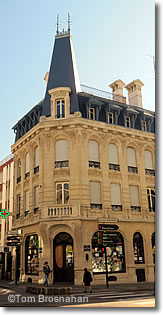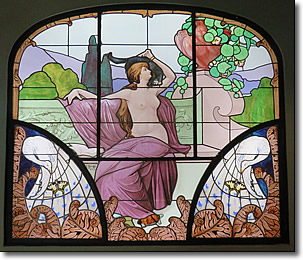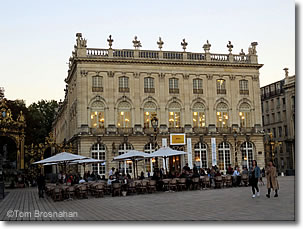 |
What to See & Do in Nancy, France | |
| Nancy's thousand years of history have produced a treat for the eyes and the mind. This is a historic city with great elegance. | ||
|
|
|
Nancy has abundant architectural and cultural wealth from its thousand-year history: Place StanislasPlanned and built between 1752 and 1755 by Duke Stanislas (1677-1766), Place Stanislas was designed to link Nancy's medieval Vieille Ville-Léopold (Old Town) with the newer city built in the time of Duke Charles III of Lorraine (1543-1608)(map). The innovative design joined the Hôtel de Ville (City Hall) with the Hôtel du Gouvernement (Ducal Government Headquarters) across a grand 125-meter-long, orderly space lined with other noble buildings, today including the Musée des Beaux-Arts, the Opéra national de Lorrain, (formerly the Bishop's palace), the Grand Hotel, and the Arc Héré, a triumphal arch. Musée des Beaux-Arts de NancyThe Musée des Beaux-Arts de Nancy holds a fine and varied collection of paintings from the 15th to 20th centuries, including works by Breughel the Younger, Caravaggio, Delacroix, Dufy, Manet, Modigliani, Monet, Modigliani, Picasso and many others. Originally a theater and medical college, the Musée building (1755) has undergone numerous changes over the centuries, including a fire in 1906, conversion to an art museum and expansion in 1930, and further expansion in the 1990s. Opéra national de LorraineAlthough the Place Stanislas included a theater, the original building was destroyed by fire in 1905, and a brand-new one built in its place, inaugurated in 1919. Designed by Joseph Hornecker, a member of the Art Nouveau École de Nancy, the new opera house is in classical style with Art Nouveau elements. More... Palais Ducale (Musée Lorrain)Once home to the powerful Dukes of Lorraine, since 1848 the 15th-century Gothic Palais des Ducs de Lorraine has been the Musée Lorrain, dedicated to the history and culture of the duchy (map). The history is long. Museum exhibits include artifacts from the Gallo-Roman and Merovingian periods, the Middle Ages, Renaissance art, and other works up to the 20th century. arms and armaments, religious sculptures and stained glass, and Jewish ritual objects are also part of the collections. Unfortunately for current visitors, the Musée is under extensive renovation and it closed to visitors in April 2018 for at least five years. Adjoining the Musée is the Église des Cordeliers (1487), which is open during renovations. More... Musée de l'École de NancyDuring the Belle Époque, Nancy was the center of an art Nouveau movement known as L'École de Nancy. Artists such as Émile Gallé, Victor Prouvé, Louis Majorelle, Antonin Daum, Eugène Vallin and Jacques Grüber lived and worked here. A wealthy art collector named Eugène Corbin bought many of their works for his superb Art Nouveau villa, and many more were added when the villa was opened in 1964 as the Musée de l'École de Nancy. The collection includes period paintings, furniture, sculptures, stained glass and glassware, decoration and other art objects, as well as a garden and an aquarium. More... Nancy CathedralIts full name is Cathédrale Notre-Dame-de-l’Annonciation et Saint-Sigisbert (Cathedral of Our Lady of the Annunciation and St. Sigisbert), so...no wonder people just call it La Cathédrale de Nancy. Unlike many famous, older French cathedrals, the Nancy Cathdral is one is not Gothic, but 17th- and 18th-century Baroque in style. Among the cathedral's most famous features is its Great Organ, begun in 1756 and modified in 1861. Église de Notre-Dame-de-BonsecoursThis 18th-century church, built on the site of an earlier chapel (1484), was designed by Emmanuel Héré, architect of Place Stanislas, to be the burial church of his patron Duke Stanislas. Dedicated in 1741, it was converted to a museum during the French Revolution, but its furnishings and religious character were restored in 1807. Duke Stanislas was also King of Poland, so the church shelters not only his tomb, but those of his wife, Catherine Opalinska, Duchess of Lorraine and Queen of Poland, and their daughter, Marie Leszczynska, Queen of France (married to Louis XV). The church is a place of pilgrimage for Poles interested in their country's history. More... Basilique Saint-Èpvre de NancyDedicated to the memory of the 6th-century bishop Èvre de Toul, the grand Basilique Saint-Èpvre de Nancy is a tall-steepled 19th-century building of Neo-Gothic design finished in 1874 on the Place Saint-Èpvre facing the equestrian statue of Duke René II of Lorraine. Known for its grandeur and its fine organ, the basilica's fame comes from its being the resting-place for the relics of Bishop Èvre, the modern spelling of whose name (Èpvre) causes linguo-glottal contortion, and confounds proofreaders the world over. (It's pronounced evr, one syllable, ignore the 'p', swallow the 'r'). More... Joan of Arc ExcursionNancy makes a good base for an excursion by car to Domrémy-la-Pucelle, birthplace of Jeanne d'Arc (Joan of Arc). More...
|
|
|





